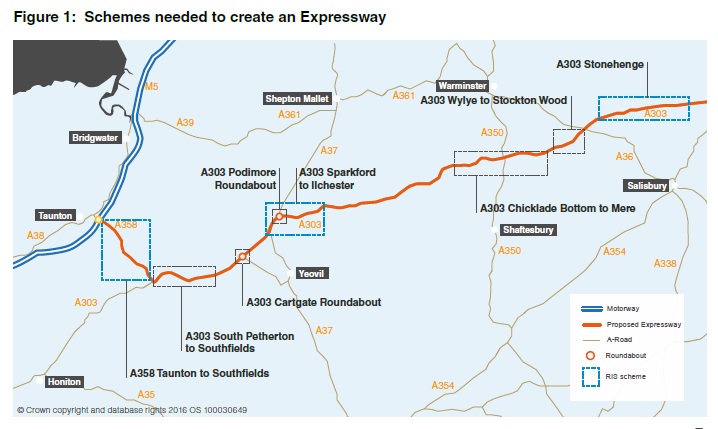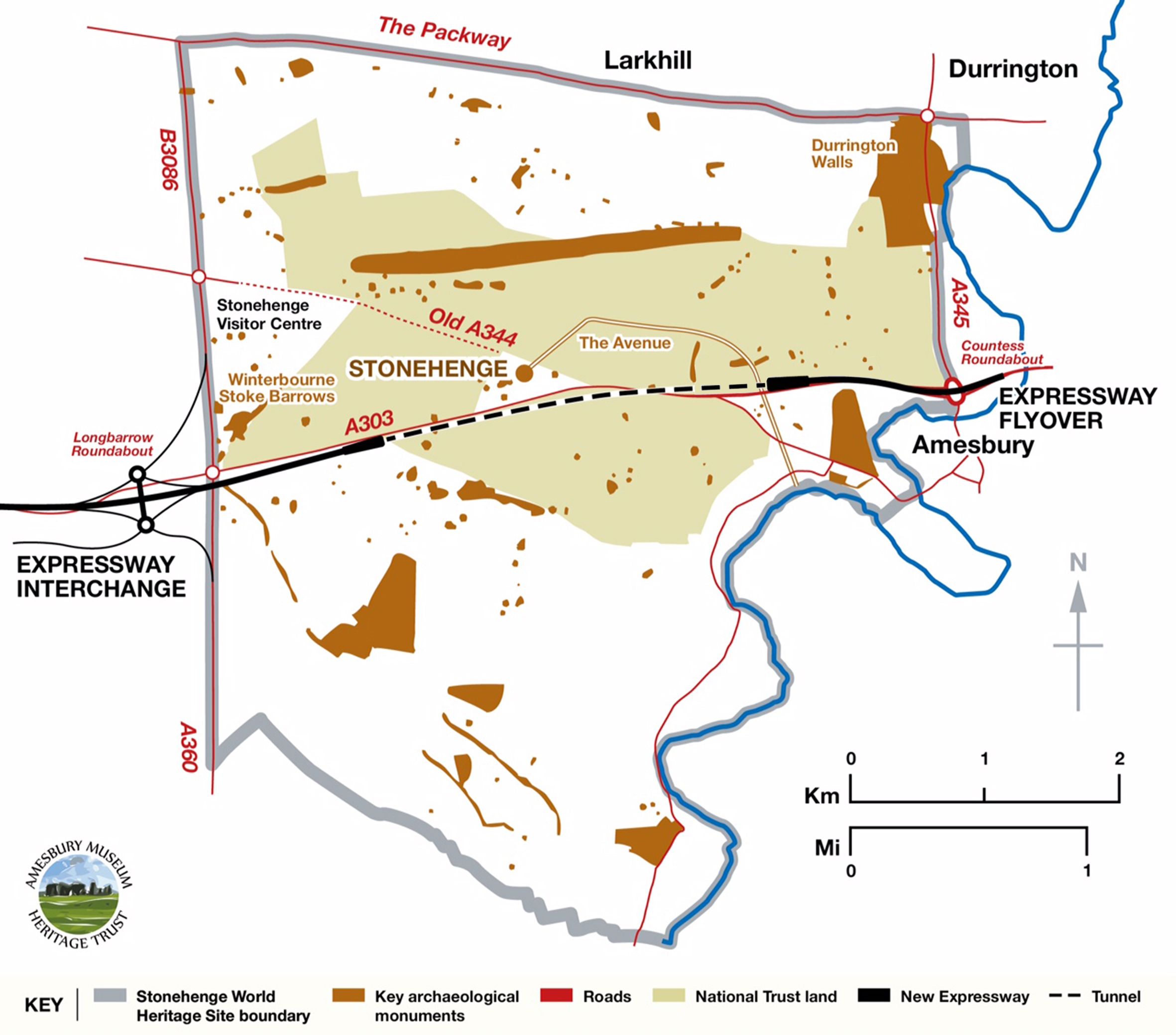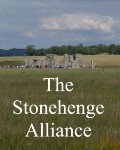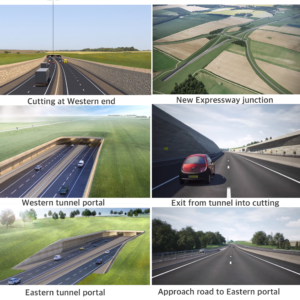Prepared by the Stonehenge Alliance [1], updated on 14 July 2023.
Current position
– Transport Secretary Mark Harper has given the go-ahead to a twin-bore 3km tunnel and some 2km of massive approach cuttings to be gouged through the unique landscape of the Stonehenge World Heritage Site (WHS). The WHS was designated by UNESCO as of “outstanding universal value” to mankind for its remarkable remains of the Neolithic and Bronze Ages.
– The Stonehenge Alliance is appalled by the Government’s decision in the face of strong advice from its Planning Inspectorate not to proceed. UNESCO’s World Heritage Committee has also condemned the scheme in its present form and has threatened placing Stonehenge on the World Heritage in Danger List, should it be allowed.
– The decision carries forward the A303 Stonehenge scheme largely unchanged to the next Road Investment spending period, RIS3. It follows the decision by the former Transport Secretary, Grant Shapps on 12th November 2020 and a lengthy period of ‘redetermination’.
– The decision goes against:
- the advice of UNESCO’s World Heritage Committee,
- it will undermine the UK’s legal commitment to address Climate Change, and
- is contrary to the advice of many experienced archaeologists.
- the recent advice of the Climate Change Committee to reconsider all major road projects in view of the Government’s commitment to significantly educe carbon emissions.
– A judicial review challenge made by Save Stonehenge World Heritage Site Ltd, a group formed by a number of supporters of Stonehenge Alliance, was successful in the High Court and the DCO was quashed in July 2021.
– The former Transport Secretary put in place a process to redetermine the DCO application. As part of that process the Secretary of State asked a series of questions of National Highways. Comments on their submissions were then invited.
– An Advisory Mission from UNESCO met the scheme promoters, supporters, objectors and various interested parties in April 2022. Their subsequent report clarifies their preference for a scheme that moves the road outside the WHS but any decision of the World Heritage Committee rests until its next meeting 10 – 13 September 2023 in Riyadh.
– Costs are now in the order of £2.5bn against a background of construction inflation and high interest rates. To date, National Highways has spent £121.28m, including legal fees, on the project (Source: National Audit Office; FOI response from National Highways).
– The road promoter has let the research, management and construction contracts. Implementation programme is understood to be:
- April 2024: Research and preparation
- April 2025: Construction starts.
- Completion 2030.
– In July and August, the Secretary of State’s approval was challenged by Save Stonehenge World Heritage Site Ltd, a group drawn from members of the Stonehenge Alliance. The case was heard were on 12, 13 and 14 December 2023. Judgment is awaited.
The A303 Stonehenge road widening scheme is illustrated here:
1. Background
The A303 Stonehenge scheme is one of eight planned improvement schemes along the A303 /A358/A30 corridor. National Highways acknowledge that the travel time benefits would not be achieved until all eight schemes have been completed.
Only three schemes have been funded. The eight schemes that make up the new A303 Expressway are illustrated in the map below.

The A303 Stonehenge (Amesbury to Berwick Down) road scheme is one of eight improvement projects. Three of which have secured funding. The benefits of the Stonehenge section will not be realised until all eight schemes have been completed. Source: National Audit Office 2019
The A303 Stonehenge Scheme Examination was undertaken in 2019 and the Examining Authority’s Report was submitted to the Secretary of State for Transport on 2 January 2020. His decision on the Scheme was twice delayed and eventually announced on 12 November.
2. What is proposed?
The Scheme would upgrade the A303 to Expressway mile-a-minute, ‘high quality, high performing’, standard with a short c.3km tunnel with twin portals in deep dual-carriageway cuttings, all within the World Heritage Site (WHS), and two grade separated junctions on its boundaries with associated slip roads. The WHS is 5.4km wide thus the tunnel would cover some 60% of the Site. See images of Highways England’s proposal.[2]
The Chancellor indicated in his Budget speech on 11 March 2020 that Her Majesty’s Government continues to support the scheme. This is subject to the transport Secretary’s redetermination (see current position above).

The World Heritage Site is 5.4km wide, but the tunnel, which is c. 3km long, would cross some 60% of the WHS.
3. HMG’s position
HMG is a signatory to the 1972 World Heritage Convention [3] and thus committed to protecting the whole World Heritage Site (WHS). Article 4 of the Convention reads:
“Each State Party to this Convention recognizes that the duty of ensuring the identification, protection, conservation, presentation and transmission to future generations of the cultural and natural heritage referred to in Articles 1 and 2 and situated on its territory [i.e., its designated World Heritage Sites], belongs primarily to that State. It will do all it can to this end, to the utmost of its own resources and, where appropriate, with any international assistance and co-operation, in particular, financial, artistic, scientific and technical, which it may be able to obtain.”
- A World Heritage Site is designated for its outstanding universal value to mankind.
- The World Heritage Convention applies to the whole WHS.
- Protecting a WHS also protects its outstanding universal value: the two are inseparable.
- Government planning policy demands protection of a WHS and its setting.
4. UNESCO’s position
HMG has invited four joint UNESCO World Heritage Centre/International Council on Monuments and Sites (ICOMOS) specialist missions (in 2015, 2017, 2018 and 2022) to see and advise on the A303 Stonehenge proposals. The 2018 Advisory Mission’s report [4] recommends exploration of bypass and longer tunnel options, saying the road scheme “should not proceed in its current form”. UNESCO’s World Heritage Committee Decisions in 2018, 2019 and 2021 [5] reiterate that advice, as does the 2022 Mission’s Report.
Ignoring UNESCO’s advice could lead to loss of World Heritage status, as the 2021 World Heritage Committee noted: leading to international condemnation.
5. Archaeological damage that would arise from the A303 scheme
- Around 26 sq. km (10 sq. miles) at Stonehenge, together with a similar area at Avebury, was designated a WHS in 1986 for its remarkable Neolithic and Bronze Age remains. These designed landscapes, with interrelated monuments and sites, include avenues and other features linked to the topography and water. Deep dual-carriageway cuttings and tunnel entrances would destroy archaeology and the integrity of the WHS.
- The A303 Preferred Route is strongly objected to by 22 archaeologists, [6] leading specialists in the archaeology of the WHS. Their views were reiterated at the Examination of the Scheme.
- The integrity of the newly discovered Blick Mead Mesolithic site, beside and possibly under the present A303, would be severely compromised by a massive flyover.
6. Consultation
The non-statutory consultation (2017) on route options was deeply flawed in offering a short (2.9km) tunnel under only part of the WHS, with bypass options to the west for Winterbourne Stoke village, i.e., a single option for the WHS, damaging to both the Site and its setting.
- Lack of information on options discarded by Highways England (including a WHS bypass), precluded informed judgement and comparison with the option chosen.
- The scheme was mainly advertised and exhibited locally by Highways England. Only one exhibition was held outside Wiltshire, at the Society of Antiquaries in London.
- Seventy-seven per cent of c.9,000 respondees to this consultation objected to the short tunnel within the WHS, irrespective of the Winterbourne Stoke bypass options.
The 2018 Statutory (February–April) and supplementary (July–August) consultations on the Preferred Route were similarly highly unsatisfactory.
- Exhibitions and publicity were largely restricted to local media and venues, with a single afternoon exhibition outside Wiltshire at the Society of Antiquaries in London.
- Information was (and still is) lacking in key areas, such as archaeology, the natural environment and hydrogeology, making fully informed judgements impossible.
- Misinformation in scheme documentation and media statements by scheme promoters continued and gave the impression that the WHS and its OUV would be protected.
- Outright objections to the scheme, including those made via Stonehenge Alliance and Friends of the Earth websites (reaching a wider group, including people from abroad) have substantially increased since the first consultation.
7. Cost and value for money
- Capital cost was set by HMG in September 2017 at an upper limit of £1.6bn. (Estimated cost was £1.3bn in December 2014). Annual tunnel maintenance costs would be c.£7m. The cost has now risen to around £2bn.
- The Scheme is to be paid for by the Public Purse. May 2019 National Audit Office and July 2019 Public Accounts Committee reports [7] have cast serious doubts on the risks and Scheme’s value for money.
- Economic assessment conclusions in the September 2017 Scheme Assessment Report [8] include:
“10.5.12. Based on those impacts that can be quantified, the Scheme is likely to lie within the low-medium value for money category of schemes.”
“10.7.1. A conventional approach to appraisal, which focuses on the traffic related benefits delivered to users of the road network, would suggest that the scheme has low value for money. However, this fails to capture the full range of benefits of the scheme and doesn’t include the value of removing the current road from Stonehenge WHS which is a key benefit of the new scheme.”
Important note: the scheme would not remove the road from the WHS.
The Whitehall Monitor 2018 [9] (Fig. 6.5 et seq.) gives a red delivery confidence rating for the A303 Stonehenge scheme in 2017: i.e., successful delivery appears to be unachievable.
8. Who stands to gain?
Supporters of the Government’s scheme:
- Historic England answers to the DCMS and is governed by the Historic England Commission which has overall responsibility for English Heritage Trust’s collections. Historic England Commissioners are among the Trustees of English Heritage Trust of which Historic England is the sole member.
- English Heritage Trust, manager of Stonehenge visitor-centre, is likely to follow HMG’s lead. The Trust would benefit from an enhanced setting to the henge and an increase in paying visitors, since motorists’ view of the Stones from the A303 would be lost.
- The National Trust owns land around Stonehenge from which the A303 would be removed into a tunnel. The Trust might also gain financially if it were to develop its own visitor-centre and charge to see the view of the Stones from the road lost to motorists in future. The support of the NT for the scheme is instrumental.
- Local people hope to be rid of traffic congestion and rat-running. Local residents are anxious about the disruption, and are not wholly supportive of the scheme. There is also fear that the road scheme would encourage further development in Amesbury, attracting more cars and lorries.
- Any traffic flow improvement would be temporary, since road widening is known to induce more traffic: see, e.g., a 2017 CPRE publication [10] which also demonstrates that widened roads rarely bring hoped-for economic benefits and increased housing to a region.
- Congestion is a national problem and Stonehenge is but one of numerous bottlenecks.
- Congestion maps reveal lengthier and more frequent congestion in other parts of the country.
9. Who stands to lose from the scheme?
- Present and future generations, who, under the terms of the WH Convention, are promised permanent protection of the WHS
- The many millions of A303 travellers, who value the view of the Stones from the road
- Those who would like to see the henge in future and would (mostly) be obliged to pay
- Our nation, whose pride in and understanding of an iconic and fundamental part of its heritage would be irretrievably lost. Note: October 2018 was the centenary of the gift of Stonehenge to the nation by Sir Cecil Chubb.
- Those concerned about the wildlife of the WHS, including the Great Bustard Group, and the RSPB whose WHS bird sanctuary hosts protected Stone Curlews.
- Our Government, whose Convention promise would be broken and, being responsible for an incalculable loss to the world, would be subject to international censure.
10. Climate change implications
Other events have arisen since completion of the Scheme Examination, and subsequent High Court Judgment, some of which we, and our allies, have already drawn the Transport Secretary’s attention to the dangers of increasing capacity for traffic.
Government advisers, such as the Office of Rail and Road, suggest that the roads investment strategy should be re-examined. The Committee on Climate Change, in its June 2020 Report said that, in terms of net zero carbon emissions, “we are not making adequate progress in preparing for climate change”; and that “Overall, the Committee recommends that investments in low-carbon and climate adaptation infrastructure must be at the heart of measures to restore economic growth following COVID-19.” The report places emphasis on home working, stating that “higher investment in resilient digital technology including 5G and fibre broadband should therefore be prioritised over strengthening the roads network.”
The International Panel on Climate Change Report published on 9 August 2021 underlines how serious the position is. There is an increasingly urgent need to reduce carbon emissions and fast – building high carbon infrastructure which willresult in more emissions is the wrong direction of travel.
The Department for Transport’s Transport Decarbonisation Plan has been strongly criticised for its inadequate and unrealistic expectations. See for instance brief analysis by Professor Greg Marsden.See for instance brief analysis by Professor Greg Marsden.
11. What should be done?
- Place the A303 Stonehenge scheme on hold. Seek alternative options not damaging to the WHS, as advised by UNESCO and the large majority of consultation respondees.
- The climate emergency declared by the Government and its commitment to net zero carbon emissions by 2050 will be accompanied by substantial changes predicted in car journeys and use over the next 10-20 years. Implementing interim traffic management measures straightaway at Stonehenge should therefore be considered.
- Road widening might not be necessary within 50 years – a small fraction of the period of human use of the WHS.
- Find better ways of spending £2bn. In terms of transport alone, the South West would benefit from a rail investment programme such as that outlined by the Peninsula Rail Task Force [11], whilst smart measures to discourage road use at busy times, improve traffic flow and prevent rat running could be implemented straight away at relatively little cost provided the local Highway Authority (Wiltshire Council) and Highways England were properly resourced to work together.
- The South West would also benefit from improved bus provision: this is an area where connectivity, especially for rural communities, is lacking. Urgent road repairs are also needed now.
- HMG should introduce statutory protection for UK World Heritage Sites, so that these highly-regarded places receive the safeguarding they need if they are to survive intact. This would not mean that no development should be allowed but that new development should not damage a WH Site’s intrinsic qualities and integrity.
For further information please contact stand.up.for.stonehenge@gmail.com
NOTES AND REFERENCES
- The Stonehenge Alliance is supported by: Ancient Sacred Landscape Network, Campaign for Better Transport, Campaign to Protect Rural England, Friends of the Earth, RESCUE: The British Archaeological Trust and many individuals in the UK and abroad. http://stonehengealliance.org.uk/
- For Highways England’s images of A303 Preferred Route, see http://stonehengealliance.org.uk/a303-stonehenge-scheme-images/.
- Convention Concerning the Protection of the World 2Cultural and Natural Heritage, UNESCO, 1972. https://whc.unesco.org/archive/convention-en.pdf
- Final Report on the joint World Heritage Centre / ICOMOS Advisory mission to Stonehenge, Avebury and Associated Sites 5 – 7 March 2018, UNESCO World Heritage Centre and ICOMOS, June 2018. https://whc.unesco.org/en/documents/168265/
- Decision: 42 COM 7B.32: Stonehenge, Avebury and Associated Sites (United Kingdom of Great Britain and Northern Ireland), UNESCO World Heritage Centre, 2018. https://whc.unesco.org/en/decisions/7261/; 2019: https://whc.unesco.org/en/decisions/7543 and 2021: https://whc.unesco.org/en/soc/4109
- “A303 Stonehenge consultation feedback from a consortium of Stonehenge experts”. Response to Preferred Route consultation, 23 April 2018. http://stonehengealliance.org.uk/wp-content/uploads/2018/06/Consultation-letter-from-Stonehenge-archaeologists-23-April-2018.pdf
- National Audit Office Report “Improving the A303 between Amesbury and Berwick Down” (May 2019): https://www.nao.org.uk/wp-content/uploads/2019/05/Improving-the-A303-between-Amesbury-and-Berwick-Down.pdf; and Public Accounts Committee Report “Transport Infrastructure in the South West” (July 2019) https://publications.parliament.uk/pa/cm201719/cmselect/cmpubacc/1753/175302.htm
- Highways England, A303 Stonehenge Amesbury to Berwick Down Scheme Assessment Report, Vol. 1, September 2017. https://highwaysengland.citizenspace.com/cip/a303-stonehenge/results/sar-volume-1.pdf
- Institute for Government, Whitehall Monitor 2018: “Delivering Major Projects”, Fig.6.5 and following text. https://www.instituteforgovernment.org.uk/publication/whitehall-monitor-2018/delivering-major-projects
- Campaign to Protect Rural England, The end of the road? Challenging the road-building consensus, March 2017. https://www.cpre.org.uk/resources/transport/roads/item/4543-the-end-of-the-road-challenging-the-road-building-consensus
- Peninsular Rail Task Force, Closing the gap The South West Peninsula strategic rail blueprint, November 2016. https://peninsularailtaskforce.files.wordpress.com/2016/11/prtf-closing-the-gap.pdf
Take action! Sign our international petition.
Please note: The Stonehenge Alliance has no connection with any other protest groups involved in direct action against A303 Stonehenge.
Please share



